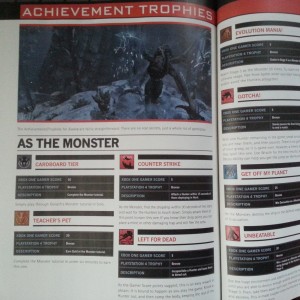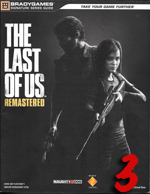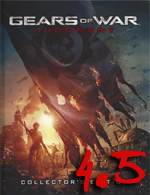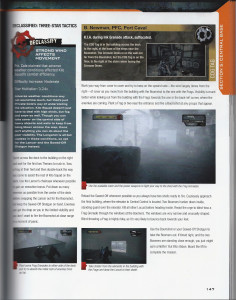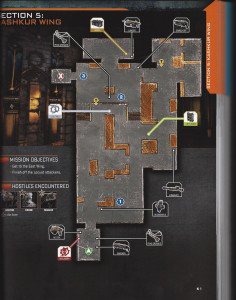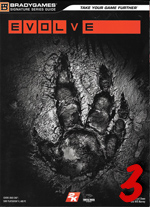 I was, and still am, excited about Evolve. The premise of four hunters taking down a giant monster totally has my interest. While I enjoy the game, sadly it’s already on the pile of “Games that Died Too Soon” thanks to a dwindling online community. Sadly, this will also be the case of the Evolve strategy guide by BradyGames.
I was, and still am, excited about Evolve. The premise of four hunters taking down a giant monster totally has my interest. While I enjoy the game, sadly it’s already on the pile of “Games that Died Too Soon” thanks to a dwindling online community. Sadly, this will also be the case of the Evolve strategy guide by BradyGames.
This is a fairly easy guide to read and understand. As I was new to the game, as in I was kept away from spoilers and such, it was nice to learn how the various weapons and skills worked. This helped me form a plan as to what hunter I wanted to concentrate on and get the most unlocks for right at the start. This is true for the monsters as well as their attacks are spelled out and easy to know what monster fit my style of play. It was also handy to know what perks to pick for both sides, as those do make a big difference.
I found the Hunters and Monsters sections to be detailed enough to help me pick a favorite hunter and monster. Having the hunter combinations that utilize their loadouts against specific monsters was a nice touch. There are tips on how each character operates and what makes them tick. However, the tips are rather basic. Telling readers that a healing class should sit back from the fight and only swoop in when needed is pretty much Gaming 101 at this point. Having more advanced strategies would have made this guide a lot more useful.
The maps are a mixed bag. I like knowing where the monster spawns in relation to where the hunters drop and the power core. The various map effect details (dependent on game mode) will help new players as they are not only fighting one another, but also the environment as well. Knowing what a man eating plant looks like will come in very handy when running away from the Goliath in hopes of living to fight another round.
While the maps are good for an overview, there isn’t much else to them. There are no prime routes marked for hunters or monsters. The lack of detail, outside of spawn and drop zone location, is very disenchanting. Having markings of where the bigger wildlife spawn points are, bird flock locations, and vantage points would have made these maps that much more useful.
For those who want to get all the accolades, badges, and achievements will find the guide is very helpful here. Accolades and badges come in spreadsheet form and contain all the info that is needed to obtain these. The nicest part about this section is that the achievements are more than just a table with the name and point value. This guide actually details out what is necessary in order to snag every achievement available. That is not something we see in a lot of guides, and it is something I’d love to see more of.
As with any guides for a game of this nature, take all numbers and stats with a grain of salt. Patches, balance tweaks, and so on can easily render the numbers in this guide useless in one fell swoop. This guide also can’t be updated with future maps and hunter releases, and so the value of this information is rather limited to the game launch window.
Overall, the Evolve strategy guide is a great introduction to what players can expect from Evolve. I found that it was easy to read while drinking coffee or over a lunch break. I then was able to plan out what I wanted to focus on and unlock during my future Evolve play sessions. However, seasoned veterans will find this is more of a Sunday read than anything that is going to actually detail out solid strategies to make one a better hunter or monster. As is the game, pick your side and determine the value of it for yourself.
SGR Rating 3/5
Author: Michael Owen and Will Murray
Publisher: BradyGames
Editions Available: Paperback
Acquired via Publisher

